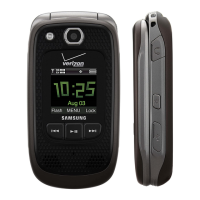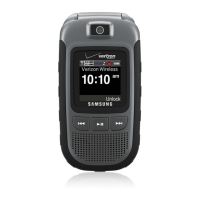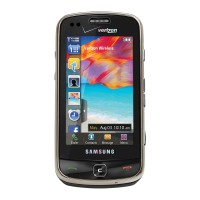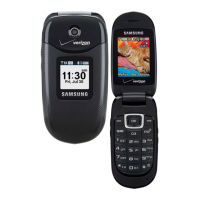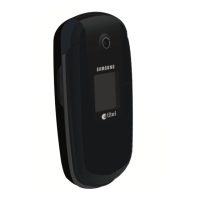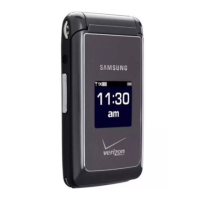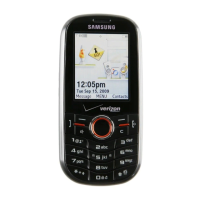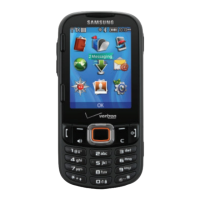Do you have a question about the Samsung SCH-U680 and is the answer not in the manual?
Explains manual structure, conventions, and simulated images.
Details phone power source, charging, and indicators.
Instructions for turning the phone on and off.
Explains voicemail functionality and setup.
Guides through initial phone setup and preference configuration.
Explains TTY compatibility and mode enabling.
Describes phone service outside home network coverage.
Covers memory card insertion, removal, and formatting.
Describes the phone's external features and components.
Details external buttons and ports on the phone's sides.
Explains internal components and key functions when phone is open.
Describes directional keys for menu navigation and shortcuts.
Explains the function of left, right, and center select keys.
Details the function of Clear Key and End/Power Key.
Explains how to use the Send Key for calls and messages.
Details usage of the key for camera and camcorder functions.
Explains using the key for voice commands and flashlight.
Describes the function of the PTT key for push-to-talk communication.
Explains how to activate speakerphone and driving mode.
Describes switching between volume and vibrate modes.
Explains the home screen layout, status bar, and shortcuts.
Outlines various methods for initiating phone calls.
Instructions for answering or sending calls to voicemail.
Details options available during an active call.
Explains how to terminate a call using the End/Power Key.
Describes how to view call history and associated icons.
Explains how to set up and initiate a fake call feature.
Guides through setting driving mode options via phone settings.
Instructions for initiating a direct PTT connection.
Steps for responding to an incoming PTT barge call.
Guide for sending a PTT alert tone to a contact.
Describes how to answer or ignore an incoming PTT alert.
Explains how to access and manage PTT contacts.
Instructions for enabling or disabling PTT mode.
Steps for creating a new contact entry.
How to save a number entered on the keypad as a contact.
Procedures for deleting contact entries.
Instructions for modifying existing contact information.
Explains actions like erasing, locking, and unlocking multiple contacts.
How to add pause/wait characters for automated systems.
Method for searching and locating contacts.
How to make calls and send messages using contacts.
Information on wireless backup service for address book.
How to assign and remove contacts from favorites for quick access.
Describes assigning contacts to categories for easier searching.
How to assign 1-, 2-, or 3-digit shortcuts to contacts.
Personal contact entry for sharing as a virtual business card.
Setting up emergency contacts and personal information.
Overview of text input modes including Abc, XT9, and symbols.
How to select preferred text input modes.
Guide to using predictive text for faster English word entry.
Guide to using predictive text for faster Spanish word entry.
Standard text entry method for mobile phones.
Instructions for entering numbers using the 123 mode.
How to enter common symbols into a text field.
Method for entering common emoticons into text fields.
Using pre-loaded or custom phrases for text messages.
Inserting internet symbols like @ or .com into text fields.
Overview of supported message types: Text, Multimedia, Email, Social.
Step-by-step guide for composing and sending messages.
How to convert text messages to multimedia messages with attachments.
Configuring options for messages, inbox, and alerts.
Options for viewing, rejecting, or saving incoming messages.
How to view and respond to incoming text messages.
Steps for viewing and interacting with multimedia messages.
Explains how messages are stored and organized.
Details the inbox folder when messages are sorted by time.
Describes the sent folder for outgoing messages sorted by time.
Managing messages created but not yet sent.
How to view, clear, and call voicemail.
Updating social networking sites and uploading media.
Instructions for sending and receiving email using the phone.
Browsing and downloading applications from the Apps store.
Steps to find and download applications.
Using the mobile web browser to access the internet.
Managing music files and setting ringtones or alert sounds.
Creating, downloading, and managing pictures and videos.
Instructions for using the phone's built-in camera.
Viewing and managing pre-loaded or downloaded pictures.
Creating a slideshow from pictures in My Pictures.
Tools for viewing and editing photos.
Instructions for using the phone's camcorder to record videos.
Viewing and managing recorded or downloaded videos.
Storing pictures in a Verizon Wireless Online Album.
Browsing and downloading applications from the Apps store.
Using GPS for location-based services and directions.
Using Media Manager to transfer media between phone and PC.
Playing music transferred from PC or memory card.
Controls and options for playing music tracks.
Steps to create and manage music playlists.
Using speech recognition to operate the phone with voice commands.
Adjusting preferences for voice command recognition and prompts.
Performing calculations, using a tip calculator, and unit conversions.
Calculating tips and splitting bills among people.
Setting up events and receiving alerts for upcoming activities.
Setting, disabling, removing, and responding to alarms.
Measuring lap times and total elapsed time.
Viewing current time in different time zones worldwide.
Creating, reading, editing, and erasing text notes.
Connecting to Verizon Wireless Mobile Web for apps and favorites.
Adjusting the volume for ringtones and alerts.
Accessing personal productivity and information applications.
Operating phone via voice commands.
Performing calculations.
Configuring PTT features and the PTT Key functionality.
Configuring sounds for calls, alerts, and key presses.
Setting sound and vibration for incoming calls.
Choosing sound/vibration settings for messages and other alerts.
Setting sounds played when pressing keys.
Adjusting the volume for key press sounds.
Enabling phone to read out numbers, menus, alerts, and messages.
Adjusting voice command preferences.
Configuring sounds for system/service status notifications.
Controlling sounds played when turning the phone on or off.
Overrides volume settings for audio alerts regardless of sound setting.
Configuring phone screen appearance settings.
Displaying personal greetings or network status banners.
Setting backlight duration and brightness for display and keypad.
Setting background images for Home and front LCD screens.
Customizing the appearance of menus and screens.
Customizing the appearance and layout of the Main menu.
Customizing menu by replacing items with favorite applications.
Changing the location of menu items on the display.
Resetting menu layout, items, and positions to defaults.
Setting the style and size of characters for display.
Adjusting the size of characters displayed on the screen.
Using volume keys to adjust font size temporarily.
Choosing clock display types for Home and Front screens.
Configuring phone-specific settings like Airplane Mode and shortcuts.
Disabling network functions to save battery or in prohibited areas.
Customizing My Shortcuts and Directional Key shortcuts.
Assigning favorite items to directional key shortcuts.
Assigning favorite applications or features to the Side Key shortcut.
Setting time period for external keys to remain active after closing phone.
Choosing the display language for the phone.
Choosing when GPS location is available to the network.
Selecting current location for correct country code dialing.
Locking phone, setting restrictions, and choosing security options.
Setting new phone-only or calls/services lock codes.
Setting restrictions for incoming/outgoing calls and messages.
Configuring phone locking behavior and power-up lock.
Immediately locking the phone and returning to Home screen.
Returning phone settings to factory defaults and erasing user data.
Returning phone settings to factory defaults without deleting data.
Setting data access preferences when outside the home network.
Setting preferences for roaming behavior.
Selecting the primary NAM for phone service.
Customizing settings for placing and receiving calls.
Selecting methods for answering incoming calls.
Configuring automatic redialing of unanswered calls.
Enabling TTY compatibility for use with TTY devices.
Controlling the speed dial feature and enabling one-touch dialing.
Encrypting voice signals for enhanced privacy on Verizon network.
Setting PTT missed call notification preferences.
Selecting PC connection port and setting maximum connection speed.
Setting DTMF tone length for automated phone systems.
Simplifying international dialing with access codes.
Using fake call feature to simulate an incoming call.
Minimizing noisy environments' effect on voice quality during calls.
Managing memory settings for saving pictures, videos, music, and ringtones.
Setting phone functionality when connecting to a PC via USB.
Viewing software/hardware info, number, icon glossary, and updates.
Configuring basic preferences for quick phone setup.
Information on RF exposure from wireless phones based on FDA data.
User cautions regarding changes/modifications and device compliance.
Receiving wireless emergency alerts from CMAS or PLAN.
Guidelines for safe mobile device use while operating a vehicle.
Important instructions for handling and storing batteries safely.
Information on recycling Samsung mobile devices and accessories.
Safety instructions for the UL-certified travel charger.
Information on display care, potential breakage, and touch-screen usage.
How the phone uses GPS and AGPS for location-based applications.
Guidelines and limitations for making emergency calls on the mobile device.
Steps to initiate an emergency call, including advice for specific features.
Recommendations for maintaining the mobile device and avoiding damage.
Advice on avoiding hearing loss from loud sounds and safe headphone use.
Precautions for using mobile devices near pacemakers and other medical implants.
FCC requirements for wireless device compatibility with hearing aids.
Warnings against letting children play with the mobile device.
Notices regarding potential interference and warranty cautions.
General safety advice regarding device handling and vehicle installation.
Details what the limited warranty covers and for how long.
Samsung's responsibilities for repair or replacement under warranty.
Steps required to get warranty service for the product.
Outlines the mandatory arbitration process for resolving disputes with Samsung.
States that unenforceability of one part does not affect the rest of the warranty.
Advice on data transfer, device disposal, and EFS Clear.
Samsung grants license rights for the software provided with the device.
Information on receiving software updates, upgrades, and supplements.
Samsung disclaims all warranties, express or implied, for the software.
Limits Samsung's liability for damages arising from software use.
Explains manual structure, conventions, and simulated images.
Details phone power source, charging, and indicators.
Instructions for turning the phone on and off.
Explains voicemail functionality and setup.
Guides through initial phone setup and preference configuration.
Explains TTY compatibility and mode enabling.
Describes phone service outside home network coverage.
Covers memory card insertion, removal, and formatting.
Describes the phone's external features and components.
Details external buttons and ports on the phone's sides.
Explains internal components and key functions when phone is open.
Describes directional keys for menu navigation and shortcuts.
Explains the function of left, right, and center select keys.
Details the function of Clear Key and End/Power Key.
Explains how to use the Send Key for calls and messages.
Details usage of the key for camera and camcorder functions.
Explains using the key for voice commands and flashlight.
Describes the function of the PTT key for push-to-talk communication.
Explains how to activate speakerphone and driving mode.
Describes switching between volume and vibrate modes.
Explains the home screen layout, status bar, and shortcuts.
Outlines various methods for initiating phone calls.
Instructions for answering or sending calls to voicemail.
Details options available during an active call.
Explains how to terminate a call using the End/Power Key.
Describes how to view call history and associated icons.
Explains how to set up and initiate a fake call feature.
Guides through setting driving mode options via phone settings.
Instructions for initiating a direct PTT connection.
Steps for responding to an incoming PTT barge call.
Guide for sending a PTT alert tone to a contact.
Describes how to answer or ignore an incoming PTT alert.
Explains how to access and manage PTT contacts.
Instructions for enabling or disabling PTT mode.
Steps for creating a new contact entry.
How to save a number entered on the keypad as a contact.
Procedures for deleting contact entries.
Instructions for modifying existing contact information.
Explains actions like erasing, locking, and unlocking multiple contacts.
How to add pause/wait characters for automated systems.
Method for searching and locating contacts.
How to make calls and send messages using contacts.
Information on wireless backup service for address book.
How to assign and remove contacts from favorites for quick access.
Describes assigning contacts to categories for easier searching.
How to assign 1-, 2-, or 3-digit shortcuts to contacts.
Personal contact entry for sharing as a virtual business card.
Setting up emergency contacts and personal information.
Overview of text input modes including Abc, XT9, and symbols.
How to select preferred text input modes.
Guide to using predictive text for faster English word entry.
Guide to using predictive text for faster Spanish word entry.
Standard text entry method for mobile phones.
Instructions for entering numbers using the 123 mode.
How to enter common symbols into a text field.
Method for entering common emoticons into text fields.
Using pre-loaded or custom phrases for text messages.
Inserting internet symbols like @ or .com into text fields.
Overview of supported message types: Text, Multimedia, Email, Social.
Step-by-step guide for composing and sending messages.
How to convert text messages to multimedia messages with attachments.
Configuring options for messages, inbox, and alerts.
Options for viewing, rejecting, or saving incoming messages.
How to view and respond to incoming text messages.
Steps for viewing and interacting with multimedia messages.
Explains how messages are stored and organized.
Details the inbox folder when messages are sorted by time.
Describes the sent folder for outgoing messages sorted by time.
Managing messages created but not yet sent.
How to view, clear, and call voicemail.
Updating social networking sites and uploading media.
Instructions for sending and receiving email using the phone.
Browsing and downloading applications from the Apps store.
Steps to find and download applications.
Using the mobile web browser to access the internet.
Managing music files and setting ringtones or alert sounds.
Creating, downloading, and managing pictures and videos.
Instructions for using the phone's built-in camera.
Viewing and managing pre-loaded or downloaded pictures.
Creating a slideshow from pictures in My Pictures.
Tools for viewing and editing photos.
Instructions for using the phone's camcorder to record videos.
Viewing and managing recorded or downloaded videos.
Storing pictures in a Verizon Wireless Online Album.
Browsing and downloading applications from the Apps store.
Using GPS for location-based services and directions.
Using Media Manager to transfer media between phone and PC.
Playing music transferred from PC or memory card.
Controls and options for playing music tracks.
Steps to create and manage music playlists.
Using speech recognition to operate the phone with voice commands.
Adjusting preferences for voice command recognition and prompts.
Performing calculations, using a tip calculator, and unit conversions.
Calculating tips and splitting bills among people.
Setting up events and receiving alerts for upcoming activities.
Setting, disabling, removing, and responding to alarms.
Measuring lap times and total elapsed time.
Viewing current time in different time zones worldwide.
Creating, reading, editing, and erasing text notes.
Connecting to Verizon Wireless Mobile Web for apps and favorites.
Adjusting the volume for ringtones and alerts.
Accessing personal productivity and information applications.
Operating phone via voice commands.
Performing calculations.
Configuring PTT features and the PTT Key functionality.
Configuring sounds for calls, alerts, and key presses.
Setting sound and vibration for incoming calls.
Choosing sound/vibration settings for messages and other alerts.
Setting sounds played when pressing keys.
Adjusting the volume for key press sounds.
Enabling phone to read out numbers, menus, alerts, and messages.
Adjusting voice command preferences.
Configuring sounds for system/service status notifications.
Controlling sounds played when turning the phone on or off.
Overrides volume settings for audio alerts regardless of sound setting.
Configuring phone screen appearance settings.
Displaying personal greetings or network status banners.
Setting backlight duration and brightness for display and keypad.
Setting background images for Home and front LCD screens.
Customizing the appearance of menus and screens.
Customizing the appearance and layout of the Main menu.
Customizing menu by replacing items with favorite applications.
Changing the location of menu items on the display.
Resetting menu layout, items, and positions to defaults.
Setting the style and size of characters for display.
Adjusting the size of characters displayed on the screen.
Using volume keys to adjust font size temporarily.
Choosing clock display types for Home and Front screens.
Configuring phone-specific settings like Airplane Mode and shortcuts.
Disabling network functions to save battery or in prohibited areas.
Customizing My Shortcuts and Directional Key shortcuts.
Assigning favorite items to directional key shortcuts.
Assigning favorite applications or features to the Side Key shortcut.
Setting time period for external keys to remain active after closing phone.
Choosing the display language for the phone.
Choosing when GPS location is available to the network.
Selecting current location for correct country code dialing.
Locking phone, setting restrictions, and choosing security options.
Setting new phone-only or calls/services lock codes.
Setting restrictions for incoming/outgoing calls and messages.
Configuring phone locking behavior and power-up lock.
Immediately locking the phone and returning to Home screen.
Returning phone settings to factory defaults and erasing user data.
Returning phone settings to factory defaults without deleting data.
Setting data access preferences when outside the home network.
Setting preferences for roaming behavior.
Selecting the primary NAM for phone service.
Customizing settings for placing and receiving calls.
Selecting methods for answering incoming calls.
Configuring automatic redialing of unanswered calls.
Enabling TTY compatibility for use with TTY devices.
Controlling the speed dial feature and enabling one-touch dialing.
Encrypting voice signals for enhanced privacy on Verizon network.
Setting PTT missed call notification preferences.
Selecting PC connection port and setting maximum connection speed.
Setting DTMF tone length for automated phone systems.
Simplifying international dialing with access codes.
Using fake call feature to simulate an incoming call.
Minimizing noisy environments' effect on voice quality during calls.
Managing memory settings for saving pictures, videos, music, and ringtones.
Setting phone functionality when connecting to a PC via USB.
Viewing software/hardware info, number, icon glossary, and updates.
Configuring basic preferences for quick phone setup.
Information on RF exposure from wireless phones based on FDA data.
User cautions regarding changes/modifications and device compliance.
Receiving wireless emergency alerts from CMAS or PLAN.
Guidelines for safe mobile device use while operating a vehicle.
Important instructions for handling and storing batteries safely.
Information on recycling Samsung mobile devices and accessories.
Safety instructions for the UL-certified travel charger.
Information on display care, potential breakage, and touch-screen usage.
How the phone uses GPS and AGPS for location-based applications.
Guidelines and limitations for making emergency calls on the mobile device.
Steps to initiate an emergency call, including advice for specific features.
Recommendations for maintaining the mobile device and avoiding damage.
Advice on avoiding hearing loss from loud sounds and safe headphone use.
Precautions for using mobile devices near pacemakers and other medical implants.
FCC requirements for wireless device compatibility with hearing aids.
Warnings against letting children play with the mobile device.
Notices regarding potential interference and warranty cautions.
General safety advice regarding device handling and vehicle installation.
Details what the limited warranty covers and for how long.
Samsung's responsibilities for repair or replacement under warranty.
Steps required to get warranty service for the product.
Outlines the mandatory arbitration process for resolving disputes with Samsung.
States that unenforceability of one part does not affect the rest of the warranty.
Advice on data transfer, device disposal, and EFS Clear.
Samsung grants license rights for the software provided with the device.
Information on receiving software updates, upgrades, and supplements.
Samsung disclaims all warranties, express or implied, for the software.
Limits Samsung's liability for damages arising from software use.
| Model | SCH-U680 |
|---|---|
| Network | CDMA 800 / 1900 |
| Status | Discontinued |
| Display Type | TFT, 256K colors |
| Display Resolution | 240 x 320 pixels (~182 ppi pixel density) |
| Call Records | Yes |
| Alert Types | Vibration; Downloadable polyphonic, MP3 ringtones |
| Loudspeaker | Yes |
| 3.5mm Jack | No |
| Messaging | SMS, MMS, Email |
| Browser | WAP 2.0/xHTML |
| Radio | No |
| Games | Yes |
| GPS | No |
| Java | Yes, MIDP 2.0 |
| Operating System | Proprietary |
| Memory Card Slot | microSD |
| Phonebook | Yes |
| Bluetooth | 2.1, A2DP |
| USB | Yes |
| Display Size | 2.2 inches |
